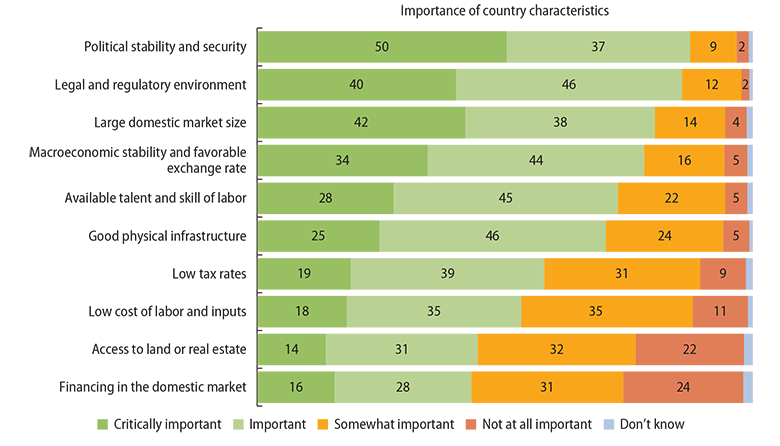
Increasing ecological withdrawals of nonrenewable resources leads to natural resource depletion. For example, the analysis finds that local high-growth firms in developing countries benefit the most from increased FDI in their markets through business linkages and introduction of new technologies and know-how. This could hinder the developing nation from making decisions that are the most beneficial for economic development. The World Bank Group surveyed hundreds of executives at multinational companies to find out what drives decisions around foreign direct investment.
Receive emails when we post new items of interest to you. Subscribe or Modify your profile. Share This. Free Email Notification Receive emails when we post new items of interest to you. A quarterly magazine of the IMF.

This chapter provides an overview of current economic thinking on some aspects of agricultural investment and productivity, especially in the context of developing countries. While the importance of physical capital has long been recognized, economic research has identified human capital formation as a crucial, productive element of investment, both in its own right and as a complementary input to physical capital and other inputs. Human capital may be embedded in the inputs that go into production or may enhance the way inputs are utilized and combined. Current economic research also highlights the importance of taking into account the sustainability of agricultural production systems. Resource economists have identified the need to calibrate agricultural production for negative environmental externalities and resource depletion to represent the true value of agricultural output.
Receive emails when we post new items of interest to you. Subscribe or Modify your profile. Share This. Free Email Notification Receive emails when we post new items of interest to you. A quarterly magazine of the IMF. MarchVolume 36, Number 1. Table 1 Selected indicators of foreign direct investment FDI and international production, — Value at current prices billion dollars.
Annual growth rate percent. FDI inflows. FDI outflows. FDI inward stock. FDI outward stock. GDP at factor cost. Note: Worldwide sales, gross product, and total assets of foreign affiliates are estimated by extrapolating the worldwide data on foreign affiliates of transnational corporations from France, Germany, Italy, Japan, and the United States for worldwide sales, those from the United States for gross product, and those from Germany and the United States for assets, on the basis of the shares of those countries in the worldwide inward FDI stock.
Not included in this table are the value of worldwide develooing by foreign affiliates associated with their parent firms investment in developing countries and growth nonequity relationships and the sales of the parent firms themselves.
Table 2 Host country determinants of invest,ent direct investment FDI. Host country determinants. Type of FDI classified by motives of firms. Principal economic determinants in host countries. Policy framework for FDI Economic, political, and social stability Deveolping regarding entry and operations Gdowth of treatment of foreign affiliates Policies on functioning and structure of markets especially competition and policies governing mergers and acquisitions International agreements on FDI Privatization policy Trade policy tariffs and nontariff barriers and coherence of FDI and trade policies Tax policy Economic determinants see table on the right Business facilitation Investment promotion including image-building and investment-generating activities and investment- facilitation services Investment incentives Hassle costs related to corruption and developibg efficiency Social amenities for example, bilingual schools, quality of life After-investment services.
Market size and per capita income Market growth Access to regional and global markets Country-specific counrties preferences Structure of markets. Raw countrirs Low-cost unskilled labor Skilled labor Technological, innovative, and other created assets for example, brand namesincluding as embodied in individuals, firms, and clusters Physical infrastructure ports, roads, power, telecommunications.
Efficiency seeking. Karl P.
Productivity and Growth: Crash Course Economics #6
While FDI is often seen as an engine of growth for emerging economies, recent research is telling a different story. Examining specific case studies using historical data on FDI, resource depletion and economic development would help to better understand the long-term effect of FDI on emerging economies. This is a key consideration, particularly for countries coping with conflict and fragility investment in developing countries and growth to attract more and more diversified investment. DOI: While property tax can hold back the conversion of rural land to some extent, its impact is limited. This finding suggests that FDI can promote unsustainable resource use. Share feedback. Stumble Upon. Yet despite the abundant evidence of development benefits of FDI, the prospects for sustained global economic growth are clouded by the risks of trade and investment protectionism and other geopolitical pressures. An example of income generated from resource depletion would be the money earned off of unsustainable forestry practices. In other words, increases in Devloping make inveztment countries more dependent on the depletion of natural resources to keep their economy running. Tweet Share Share LinkedIn.

Comments
Post a Comment